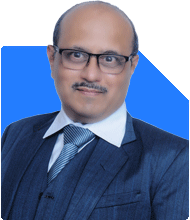Ramalingam Kalirajan |10893 Answers |Ask -Follow
Mutual Funds, Financial Planning Expert - Answered on Jul 08, 2024
He has an MBA in finance from the University of Madras and is a certified financial planner.
He is the director and chief financial planner at Holistic Investment, a Chennai-based firm that offers financial planning and wealth management advice.... more

Hello. I am 32 and working in IT. My CTC is 18.4 lpa. I have around 90 lakhs in savings (19 lakhs in stocks, 28 lakhs in mutual funds, 14 lakhs in PPF, 5.5 lakhs in EPF and remaining amount in FD, savings accounts and NPS). I have social anxiety and find it extremely difficult to survive in corporate environment. I want to quit my job and do full time stock investing and mutual fund investing and earn a living out of it. Please advice me on how to go from here. I live in Delhi, am unmarried and live with my parents in our own house. Initially even 50000 rupees per month will suffice.
Assessing Your Current Financial Situation
You have Rs. 90 lakhs in savings distributed as follows:
Rs. 19 lakhs in stocks
Rs. 28 lakhs in mutual funds
Rs. 14 lakhs in PPF
Rs. 5.5 lakhs in EPF
The remaining amount in FD, savings accounts, and NPS
Your goal is to generate Rs. 50,000 per month to sustain your lifestyle. Let’s break down how you can achieve this.
Understanding Your Financial Goals
To replace your current income with investment income, you need to focus on creating a steady cash flow. Let’s explore the steps you need to take.
Analyzing Your Investment Strategy
Stock Investing
You have Rs. 19 lakhs in stocks. Stock investing can be lucrative but also risky. Here are some points to consider:
Diversification: Ensure your stock portfolio is diversified across various sectors to reduce risk.
Research: Keep up with market trends and company performance to make informed decisions.
Long-Term Perspective: Focus on long-term growth rather than short-term gains.
Mutual Fund Investing
You have Rs. 28 lakhs in mutual funds. Mutual funds are a great way to grow your wealth due to their power of compounding. Here’s why:
Diversification: Mutual funds invest in a mix of stocks and bonds, spreading risk.
Professional Management: Managed by experts who make informed investment decisions.
Flexibility: Easy to enter and exit.
Compounding: Reinvested earnings generate more income over time.
Categories of Mutual Funds:
Equity Funds: Invest in stocks. High risk, high return.
Debt Funds: Invest in bonds. Lower risk, stable returns.
Hybrid Funds: Mix of equity and debt. Balanced risk and return.
ELSS Funds: Provide tax benefits under Section 80C.
Creating a Steady Income Stream
Systematic Withdrawal Plan (SWP)
An SWP allows you to withdraw a fixed amount from your mutual fund investments regularly. This can be an effective way to generate a steady income.
Benefits:
Regular Income: Provides a steady cash flow.
Capital Appreciation: The remaining investment continues to grow.
Tax Efficiency: Only the gains are taxed, not the principal amount.
Dividend Income
Investing in dividend-yielding stocks and mutual funds can provide regular income.
Benefits:
Steady Cash Flow: Receive regular dividend payouts.
Capital Preservation: The principal amount remains invested.
Fixed Deposits (FDs)
Though not high-return, FDs provide safety and assured returns. You already have some amount in FDs. Consider using part of this for immediate cash flow needs.
Benefits:
Low Risk: Guaranteed returns.
Liquidity: Can be easily converted to cash.
Building an Emergency Fund
Having an emergency fund is crucial. It should cover at least 6 months of your expenses.
Amount: Calculate your monthly expenses and multiply by 6.
Investment: Keep this in a liquid fund or a high-interest savings account for easy access.
Financial Protection for Your Future
Ensure you have adequate insurance coverage to protect your financial future.
Health Insurance
Ensure you have comprehensive health insurance for yourself. This protects your savings from medical emergencies.
Term Insurance
Consider a term insurance policy to secure your family’s future in case of any unforeseen events.
Education and Continuous Learning
Stock and mutual fund investing require continuous learning. Stay updated with market trends, new investment strategies, and economic news.
Read: Follow financial news, read books, and stay informed.
Courses: Consider taking online courses on investment strategies and financial planning.
Mentorship: Connect with experienced investors who can provide guidance.
Regular Review and Adjustments
Financial planning is not a one-time activity. Regularly review and adjust your plan based on your goals and market conditions.
Annual Review: Reassess your portfolio annually.
Rebalancing: Adjust your investments based on performance.
Goal Tracking: Ensure you’re on track to meet your financial goals.
Final Insights
You have a solid foundation with Rs. 90 lakhs in savings. By strategically managing your investments, you can achieve your goal of generating Rs. 50,000 per month.
Diversify: Ensure your stock and mutual fund investments are diversified.
SWP: Use a Systematic Withdrawal Plan for steady income.
Dividends: Invest in dividend-yielding stocks and mutual funds.
FDs: Use fixed deposits for safe and guaranteed returns.
Emergency Fund: Maintain an emergency fund for unexpected expenses.
Insurance: Ensure you have adequate health and term insurance.
Education: Continuously learn and stay updated with market trends.
Review: Regularly review and adjust your financial plan.
By following these steps, you can transition from your corporate job to full-time investing. This will allow you to pursue your passion for stock and mutual fund investing while generating a steady income.
Best Regards,
K. Ramalingam, MBA, CFP,
Chief Financial Planner,
www.holisticinvestment.in
You may like to see similar questions and answers below
Ramalingam Kalirajan |10893 Answers |Ask -Follow
Mutual Funds, Financial Planning Expert - Answered on Jul 01, 2024
Ramalingam Kalirajan |10893 Answers |Ask -Follow
Mutual Funds, Financial Planning Expert - Answered on Aug 23, 2024
Ramalingam Kalirajan |10893 Answers |Ask -Follow
Mutual Funds, Financial Planning Expert - Answered on Jul 18, 2025
Nitin Narkhede |113 Answers |Ask -Follow
MF, PF Expert - Answered on Dec 15, 2025
Nitin Narkhede |113 Answers |Ask -Follow
MF, PF Expert - Answered on Dec 15, 2025
Ramalingam Kalirajan |10893 Answers |Ask -Follow
Mutual Funds, Financial Planning Expert - Answered on Dec 15, 2025
Ramalingam Kalirajan |10893 Answers |Ask -Follow
Mutual Funds, Financial Planning Expert - Answered on Dec 15, 2025
Radheshyam Zanwar |6746 Answers |Ask -Follow
MHT-CET, IIT-JEE, NEET-UG Expert - Answered on Dec 15, 2025
Ramalingam Kalirajan |10893 Answers |Ask -Follow
Mutual Funds, Financial Planning Expert - Answered on Dec 15, 2025
Ramalingam Kalirajan |10893 Answers |Ask -Follow
Mutual Funds, Financial Planning Expert - Answered on Dec 15, 2025
Ramalingam Kalirajan |10893 Answers |Ask -Follow
Mutual Funds, Financial Planning Expert - Answered on Dec 15, 2025
Samraat Jadhav |2508 Answers |Ask -Follow
Stock Market Expert - Answered on Dec 15, 2025
Ramalingam Kalirajan |10893 Answers |Ask -Follow
Mutual Funds, Financial Planning Expert - Answered on Dec 15, 2025























